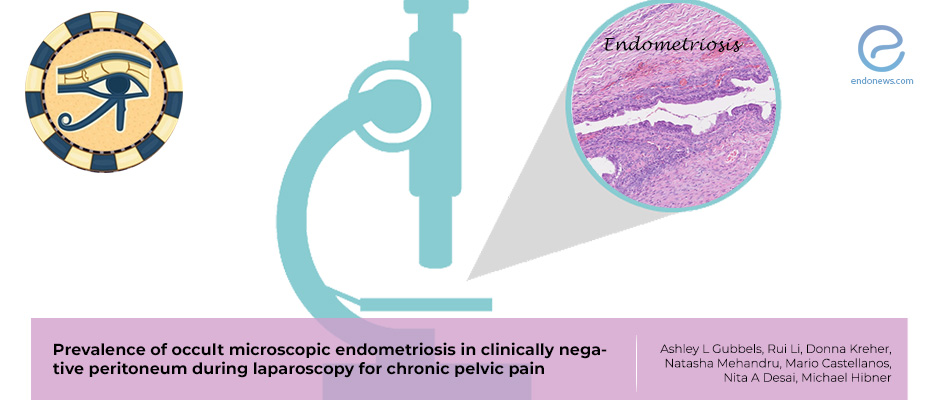Occult microscopic endometriosis in clinically negative peritoneum
Jul 14, 2020
Patients with chronic pelvic pain who are clinically negative appearing peritoneum by laparoscopy may have occult microscopic endometriosis.
Key Points
Highlights:
- Approximately 39% of patients with clinically negative-appearing peritoneum undergoing laparoscopic evaluation for chronic pelvic pain had occult microscopic endometriosis.
Importance:
- Based on the findings of the present study, peritoneal biopsies should be performed in all patients undergoing laparoscopy for pelvic pain who do not have visible endometriosis.
-
A patient with negative biopsies does not truly confirm the absence of endometriosis in this particular patient.
What's done here:
- The authors conducted a retrospective cross-sectional study analyzing data of women who underwent laparoscopic evaluation for chronic pelvic pain.
- Three fellowship-trained gynecologic surgeons at a community-based referral center conducted operations over a 6-year time period.
Key Results:
- Among 142 clinically negative patients, 39% had occult microscopic endometriosis in their random laparoscopic peritoneum biopsy.
- In the biopsy-negative group, the level of cramps with menses was higher.
- The age of menarche, pain during various parts of the menstrual cycle, or duration of symptoms was not different in both groups.
Limitations:
- The biopsy sites were not standard, and the individual biopsy sites were not recorded.
- This study is of a retrospective nature.
- The present study is not able to detect total differences in menstrual and pain characteristics.
Lay Summary
Occult microscopic endometriosis may be present in approximately 39% of patients with clinically negative appearing peritoneum undergoing laparoscopy for chronic pelvic pain.
This finding is presented in a study published online this month in the International Journal of Gynecology & Obstetrics. The multi-disciplinary collaborative study was led by researchers at St. Joseph’s Hospital and Medical Center in Phoenix, Arizona University of Rochester Medical Center in Rochester, New York, USA.
The leading author, Gubbels et al. evaluated the prevalence of microscopic endometriosis by retrospectively analyzing data from 865 patients who underwent laparoscopic evaluation for chronic pelvic pain fellowship-trained gynecologic surgeons in a community-based referral center from January 2011 to December 2016. They identified 142 patients with clinically negative peritoneum on laparoscopy for chronic pelvic pain. Among this negative group, 39% had occult microscopic endometriosis in their random laparoscopic peritoneal biopsy.
The level of cramps with menses was found to be higher in the biopsy-negative group. The authors’ explanation for this is that patients without occult microscopic endometriosis have a higher incidence of primary dysmenorrhea or adenomyosis and their pain more likely results from the uterus itself.
In the current study, it is stated that whether the finding of occult microscopic endometriıosis is truly the reason for pain in the biopsy-positive group is not certainly known. They advise treatment of pain with tricyclic antidepressants or anticonvulsants, particularly in cases unresponsive to hormonal suppression.
No differences were found in the age of menarche, pain during various parts of the menstrual cycle, or duration of symptoms. The biopsy-positive group was younger at the time of evaluation. Neither biopsy results nor menstrual or pain characteristics were affected by the current use of hormones. No significant difference was seen between robotic and laparoscopic cases. Morbidity due to operation was minimal.
Authors recommend performing peritoneal biopsies, especially from anterior and posterior cul de sacs and bilateral ovarian fossa, in all patients undergoing laparoscopy for pelvic pain who do not have visible endometriosis lesions. They underlined the need to determine if chronic pelvic pain may be caused by occult microscopic endometriosis and to find alternative methods to identify lesions that are undetectable.
Research Source: https://pubmed.ncbi.nlm.nih.gov/32644227/
pelvic endometriosis microscopic endometriosis negative laparoscopy; occult endometriosis occult microscopic endometriosis

